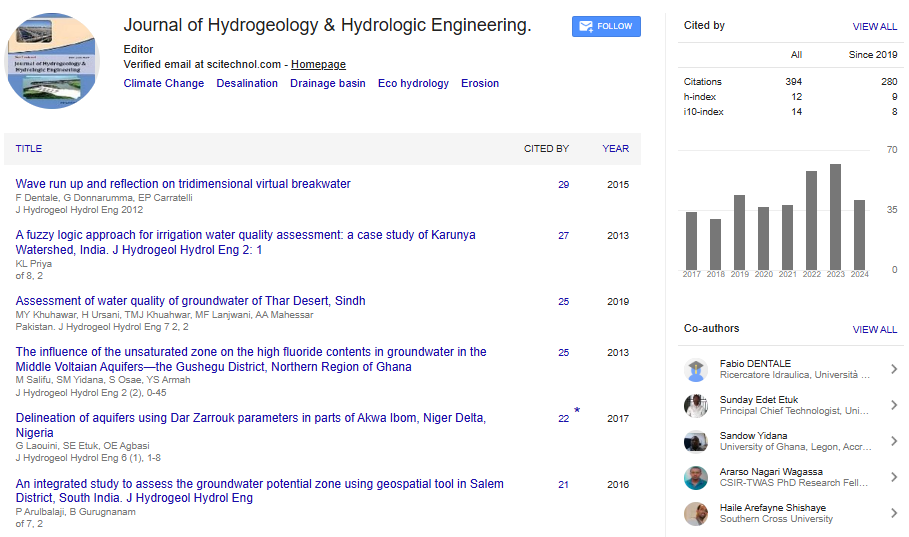Opinion Article, J Hydrogeol Hydrol Eng Vol: 13 Issue: 3
Vadose Zone Hydrology: The Earth's Subsurface Unsaturated Layer
Ryan Winston*
1Department of Water Sciences, Beijing Normal University, Beijing, China
*Corresponding Author: Ryan Winston,
Department of Water Sciences, Beijing
Normal University, Beijing, China
E-mail: winstonr38@gmail.com
Received date: 27 May, 2024, Manuscript No. JHHE-24-144608;
Editor assigned date: 30 May, 2024, PreQC No. JHHE-24-144608 (PQ);
Reviewed date: 13 June, 2024, QC No. JHHE-24-144608;
Revised date: 21 June, 2024, Manuscript No. JHHE-24-144608 (R);
Published date: 28 June, 2024, DOI: 10.4172/2325-9647.1000328
Citation: Winston R (2024) Vadose Zone Hydrology: The Earth's Subsurface Unsaturated Layer. J Hydrogeol Hydrol Eng 13:3.
Description
The vadose zone, also known as the unsaturated zone, is a precarious component of the Earth's subsurface that plays a pivotal role in the hydrological cycle. Located between the ground surface and the water table, the vadose zone is where water from precipitation infiltrates and percolates downward to replenish groundwater reserves. This zone is characterized by a mixture of air and water in the pore spaces of soil and rock, distinguishing it from the saturated zone below the water table, which is completely filled with water. The vadose zone's composition varies significantly based on soil type, rock formations, and climatic conditions. It typically consists of three layers: The root zone, the intermediate zone, and the capillary fringe. The root zone is the uppermost layer where plant roots extract water and nutrients. Below this, the intermediate zone extends to varying depths and is essential for the downward movement of water. The capillary fringe, just above the water table, is where water is drawn upward by capillary action, saturating the soil.
Water movement in the vadose zone is governed by several processes, including infiltration, percolation, and evaporation. Infiltration is the process by which water enters the soil surface, influenced by soil texture, structure, and antecedent moisture conditions. Once infiltrated, water moves downward through the soil profile in a process known as percolation, driven by gravity and capillary forces. The rate of percolation depends on soil permeability and the presence of preferential flow paths, such as cracks or root channels. One of the primary functions of the vadose zone is to facilitate groundwater recharge. As water percolates through the vadose zone, it eventually reaches the water table, replenishing the aquifer below. The efficiency of this process depends on factors such as soil moisture content, depth of the vadose zone, and the presence of impermeable layers. In arid and semi-arid regions, where precipitation is limited, the vadose zone plays an even more essential role in sustaining groundwater resources.
The vadose zone also acts as a filter and buffer for contaminants, affecting their transport and fate. Contaminants from surface activities, such as agricultural runoff, industrial spills, or leaching from waste disposal sites, can infiltrate into the vadose zone. The physical, chemical, and biological processes within the vadose zone determine the extent to which contaminants are attenuated or transported to the groundwater. Understanding these processes is essential for managing and mitigating groundwater pollution. Land use changes, such as urbanization, deforestation, and agricultural practices, significantly impact the hydrology of the vadose zone. Urbanization increases impervious surfaces, reducing infiltration and increasing surface runoff, which can lead to reduced groundwater recharge and increased flooding. Agricultural practices, particularly irrigation and the application of fertilizers and pesticides, alter the soil moisture regime and introduce contaminants into the vadose zone.
Climate change further exacerbates these impacts by altering precipitation patterns, increasing the frequency and intensity of extreme weather events, and affecting evapotranspiration rates. These changes can lead to shifts in the vadose zone's hydrological processes, influencing groundwater recharge rates and contaminant transport dynamics. Research in vadose zone hydrology involves a multidisciplinary approach, integrating soil science, hydrology, geology, and environmental engineering. Advanced techniques, such as remote sensing, geophysical methods, and numerical modeling, are employed to study the vadose zone's characteristics and processes. Field experiments and laboratory studies provide valuable data for understanding water flow and solute transport mechanisms.
Conclusion
Vadose zone hydrology is a vital aspect of the Earth's hydrological cycle, influencing groundwater recharge, contaminant transport, and overall water availability. As human activities and climate change continue to impact the vadose zone, understanding its processes and dynamics becomes increasingly important for managing and protecting our precious groundwater resources. Continued research and informed management practices are essential to safeguarding the vadose zone's role in sustaining the Earth's water supply. Effective management of the vadose zone requires a comprehensive understanding of its hydrological and environmental functions. Strategies for sustainable groundwater management include protecting recharge areas, implementing best management practices in agriculture, and mitigating the impacts of urbanization. Policymakers and water resource managers must consider the complex interactions within the vadose zone to ensure the long-term sustainability of groundwater resources.
 Spanish
Spanish  Chinese
Chinese  Russian
Russian  German
German  French
French  Japanese
Japanese  Portuguese
Portuguese  Hindi
Hindi 
